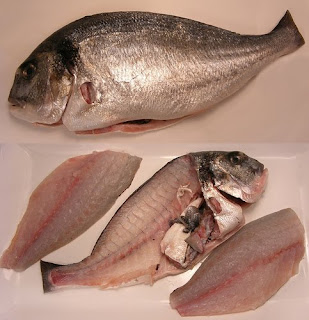Greetings Chefs and Buyers,
Well, we still have some crayfish from this mornings shipment crawling about the warehouse, so you can still get them in your pots. The same flight also had our regular shot of West Coast oysters and manila clams as well as some spectacular sturgeon bullets.
If you are into local and reasonably priced fish you might want to consider the following options:

- Haddock (dayboat) Cape Cod, MA
- Porgies (hand line) Long Island, NY
- Kitten Tile (seine net) Beaufort, NC
- Spanish Mackerel (line caught) Beaufort, NC
- Blackfish (Trap) Point Pleasant, NJ
From Florida we are still getting Stone Crab and some octopus that are caught in the same traps (they come looking for an easy meal). Fresh shrimp are sized 16/20, they cook up sweet and crisp in a league of their own.
From the other side of the world we have Hiramasa ,yellowtail kingfish
Seriola lalandi, also known as gold striped amberjack, it is a natural inhabitant of the waters off South Australia. We source ours from a highly regarded and sustainable farm that rears the fish from egg to harvest size.
http://www.cleanseas.com.au/fish/kingfish.html Fed a diet free of antibiotics or hormones this fish is considered a better alternative to Japanese hamachi. Hiramasa can be used for many applications including crudo and grill.
Dover sole, Chilean turbot, Nova Scotia halibut and Pemaquid mussels are also available today.
Striped bass and Black sea bass are in very limited supply due to heavy seas, please let us know your choice of sub if you try to order either fish.
| "Integrity is the essence of everything successful." |
|  Richard Buckminster Fuller Richard Buckminster Fuller
Matthew Hovey matth@wildedibles.com
718-433-4321 ext.121 / fax 718-433-4616
"Hand picked specialties from the Seas"
www.wildedibles.com
http://seafoodshop.blogspot.com/
Popular posts from this blog

I often find it necessary to explain the yield (amount of usable flesh) off of various fish. By knowing what percentage of meat will be available when a whole fish is filleted one can make an accurate analysis of; A. how much whole fish must be purchased and B. what is the true fillet cost. Knowing how to correctly perform these calculations will benefit not only seafood suppliers, restaurant chefs, but also the casual cook. Below is a list of some common fish and the net yield percentages. Actual percentages may vary depending on skill of the butcher. Salmon (head-on gutted) yields 75% skin-on fillet Snapper (head-on gutted) yields 40% skin-on fillet Mahi (headed and gutted) yields 65% skin-on fillet Monkfish (tail) yields 70% skinless fillet Cod (headed and gutted) yields 60% skin-on fillet Grouper (head-on gutted) yields 35% skinless fillet Halibut (headed and gutted) yields 66% skin-on fillet Tuna (headless bullets) yields 75% untrimmed loins Sword (headless bullets) yields 80% cen...
Ever wonder what the differences are between Sole and Flounder? Some customers recently asked me the question so I thought I would take a moment to shed a bit of light on the subject. Here in North America we have no true sole only flounders. When Europeans came to the Americas they called flounders soles because they looked like the fish they knew in the "old world". This has led understandably to much confusion over the years. The only true sole would be Dover Sole, Solea solea . Lemon sole is one of the names given to winter flounder, Pseudopleuronectes americanus , (also known as black back). Usually at the retail level when multiple flounder sku's are sold; flounder is the name given to the refreshed less expensive product, and sole (or lemon sole) is the name given to the more expensive fresh cut product. Fluke, Paralichthys dentatus also called summer flounder can also be sold as sole fillet. Sometimes there is a distinction ...
Top Catch Timed Caught in Time Frozen portioned in same format as TBD. Matt Hovey Have fish, will travel 727-504-3819
|

![]() Richard Buckminster Fuller
Richard Buckminster Fuller

Comments